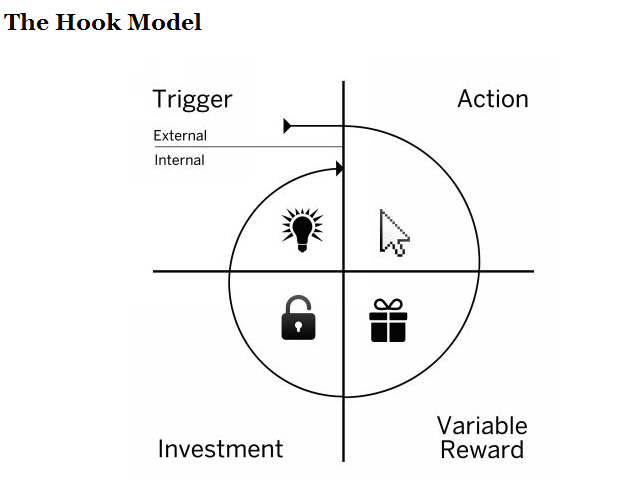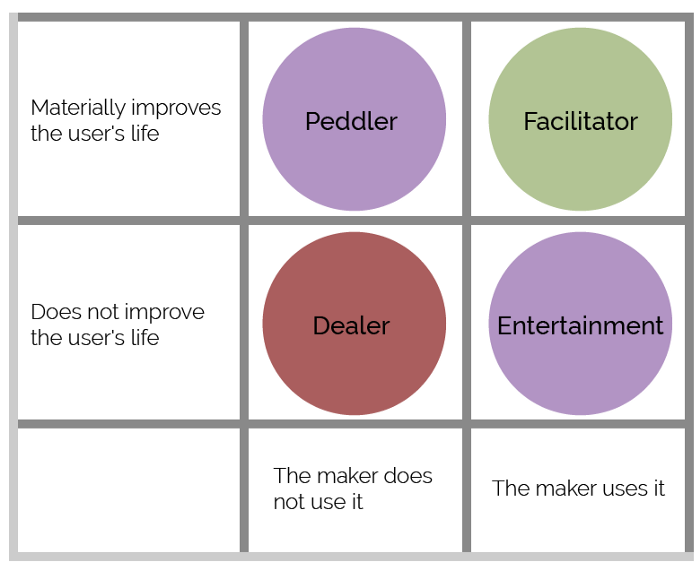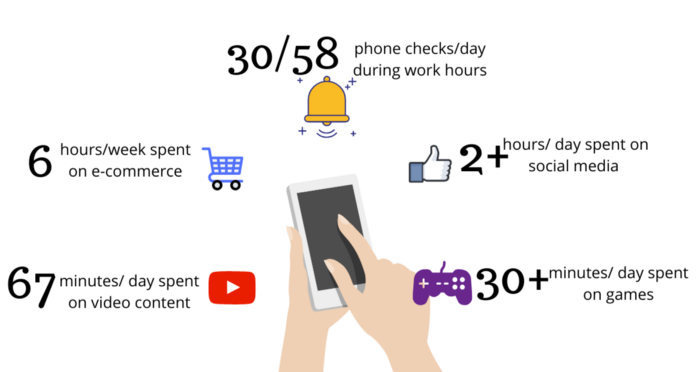As an aspiring PM, a popular interview question is “how would you improve this product?”. There are several ways to improve various metrics, but ideally, the first step is to understand the mechanics of products users seem to be addicted to.
Intrigued (and mostly astonished) by the amount of time I spend on my phone, I decided to read the highly recommended book, Hooked. In this book, Nir Eyal walks us through a simple framework to build habit-forming products based on consumer behavior and psychology.
Hooked doesn’t tell you how to come up with amazing ideas, but how to take a product to the next level and drastically improve user engagement and satisfaction. The Hook Process outlines 4 steps in creating these types of products: Trigger, Action, Variable Reward, and Investment. These steps build on the premise that to increase engagement, you need to attach your product to your user’s routines and habits.

Trigger
Triggers act as the initial push that prompt users to do some sort of action- preferably to open and interact with your product. These can be external (notifications, alerts) or internal (an emotion or need you have).
External:
- paid triggers: established through marketing and ads. Since these are expensive, these are used to acquire new users NOT re-engage existing users.
- earned triggers: when your content or product is featured and popular users tend to check it out. However, these are usually short-lived.
- relationship triggers: word-of-mouth through family and friends drives users to explore and adopt new products.
- owned triggers: when users willingly sign up for notifications or newsletters.
Internal: when products become attached to emotions, thoughts, or routines. More commonly, negative emotions such as boredom, confusion, or loneliness prompt mindless action.
If the product alleviates the pain or meets the desire during these times, the bond between user and product is created and strengthened.
Eyal goes to say that to account for this during product development, it is important to identify user frustrations and emotions. However, actions don’t directly correlate to what we are thinking or feeling. In this case, following the 5-WHY method can get to the core of user behaviors and identify true pain points. Tying product triggers to this kind of internal “itch”, as Eyal calls it, will help turn it into a habit. This is commonly done during the user research phase when teams identify personas and journeys.
Action
Now that the user gets the nudge in one way or another, the next step is to lead them to easy and accomplishable action.
Action = Motivation + Ability + Trigger (MAT)
Eyal attributes a successful action to a combination of motivation, ability, and trigger.
- motivation: this is the level of desire we have to do an action. The right motivations create action because they promise desirable outcomes. Often these are to seek pleasure (avoid pain), seek hope (avoid fear), and seek acceptance (avoid rejection).
- ability: this is the number of steps necessary to complete a task. The easier it is to get the solution, the higher the adoption rates. To simplify a product, the goal is to remove as many obstacles as possible such as time, money, and mental or physical effort. People are always distracted and many don’t want to learn how to use your product. Designers can follow industry-standard when deciding user flows and interactions to help increase ability.
- trigger: though we covered this above, Eyal jumps into some heuristics to convince people to act. Things like scarcity (a certain number of spots left), framing effect (perceptions on if something is a loss or a gain), anchoring effect (people anchor to specific information when making decisions), and endowed progress (increased motivation when people believe they are closer to a goal).
Variable Reward
In this step, you reward the user by solving their problem and reinforcing their motivation for the action. However, once users start to predict the finite rewards, their appeal/engagement is gone.
This is why varied rewards are best to satisfy user needs while leaving them wanting to re-engage with the product at another time.
Eyal groups varied reward into 3 categories:
- rewards of the tribe: these are social rewards based on connectedness with other people and validation. Examples are Facebook likes and Quora answer upvotes.
- rewards of the hunt: this focuses on our need to acquire material objects or information that aids our survival. One example is Twitter feeds. The more we follow, the more relevant content we get.
- rewards of the self: these are all about intrinsic motivation and personal forms of gratification. Anything that is attached to things like competency, mastery, and completion. One example is video games where you try to get through all the levels.
Many successful apps offer multiple varied awards as the user interacts with the product. However, rewards must fit into the idea of the product and align with the user’s internal triggers or motivations- not just anything random. Gamification if one that may not apply to many situations.
Investment
One of the most important factors in habit formation is to change the user’s attitude or perception about the behavior so it doesn’t seem like a chore. Little investments lead to bigger changes early on and as our perceptions and behaviors change, actions become habits.
Eyal references the “escalation of commitment” which states that the more we invest time and effort into a product, the more we value it.
With investments, there is no instant gratification like with varied rewards. Instead, they signify the anticipation of longer-term rewards. Habit-building products leverage the user’s understanding that the product will get better with use (more personalization, more new content). The stored value we put into these products can be:
- content: the more users accumulate content (ex. Spotify playlists), personalize (custom preferences), and create content (ex. Instagram pictures) on one service, the less likely they are to switch to another because of the effort they put in.
- data: adding their data onto a platform acts as an archive of information they would rather not move (ex. LinkedIn profile)
- reputation: people stick to services they invested in for a higher quality score (ex. quora ratings vs other competitor sites)
- skill: investing time/effort in learning how to use the product. The more they get used to the product and figure it out, the more likely they will stick with it because switching will cause friction with their past behavior.
The important thing to remember with investments is to time them right after the user gets their reward because it is in our human nature to reciprocate. Furthermore, it is vital to stage investments in small chunks and build up to harder tasks. Once an investment is done, load in the next triggers. Eventually, this process will become internal and the user will have formed it into a habit.
Social/Corporate Responsibility
After looking at the above model, it seems that we are equipped to making users do whatever we want them to. However, more than money or fame, we have a social responsibility to create products and services that aim to help people form good habits. As a self-check, Eyal says that all product creators should ask themselves two questions:
1. Would I use the product myself?
2. Will the product help users materially improve their lives?
His “Manipulation Matrix” below identifies the 4 possible types of creators

- dealer: dealers will end up essentially exploiting users and get a low chance of success because of the moral problems that may come up.
- entertainer: products in this category often lose traction because they have to keep up with constantly changing demands that come with entertainment.
- peddler: peddlers seem to be doing good but may lack in authenticity because of a disconnect between the product and understanding the user.
- facilitator: and of course, those who do good have the highest chance of success because they believe in the product and closely understand user needs.
In this day and age, everyone wants to make the next TikTok or the next Facebook without looking at the effects they would have on users and if they truly meet what people are looking for.
In my recent Informatics Ethics & Policy class, there was one particular piece that struck me. This article talks about how regardless of all the technological developments we have made, there are still no solutions to some of the world’s biggest problems such as equal access to education, decaying infrastructure, or climate change. Instead, the most popular apps and products seem to just deliver goods to our doors. That’s why I think it is great that Eyal makes it a point to address that these methods should be used to facilitate good habits instead of manipulating users into surfing the web for hours at an end.
Habit Testing
The last section of the book covers how to identify room for improvement in existing products.
- Identify: clarify who your habitual users are and how often they are using the service. Next, compare it to how many users should be using it and try to understand the target user better.
- Codify: After looking at habitual users, determine your product’s habit path. A habit path is the process of similar steps a majority of your users take to interact with your app. Look at the steps involved, entrance points, difficulty, and order of the flow.
- Modify: Lastly, you have to revisit and redesign your product to nudge users to follow the same habit path for better engagement and results.
The most important thing I have learned from this book is to understand the psychology of why we do certain things and how tapping into perceptions will help to better frame products and make them habits. Eyal ends by asking us to question why we do/do not do certain things and how they could be made easier.
Final Thoughts
Hooked was an insightful read and it was one that got me trying to figure out triggers and investment actions for products I have worked on in my internships and projects. Though it put into words concepts I have encountered and learned, the core of the idea is all about understanding the user and their journey. More than product features or beautifully designed interactions, the success of the product relies on its emotional ties to pre-existing routines that meet customer needs. At the end of the day, each product has an insane level of competition on the market. The differentiating factor is identifying pain points and presenting your solution right when it is needed.
You can find Meghana on Medium or LinkedIn








